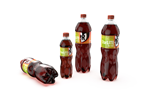Ultralight PET Preform Design
The Factor 101 design created by KHS and Husky uses just 5.89 g of material to hold 591 mL of product — equivalent to a 20-ounce water bottle.
KHS introduced one of the world’s lightest PET bottles for still beverages, collaborating with preform injection molding technology supplier Husky Technologies. Dubbed Factor 101, the design uses just 5.89 g of material to hold 591 mL of product, matching the common 20-ounce water bottle size common in the U.S.
In the U.S., the standard lightweighted PET container, which holds 500 mL of still water, usually weighs 7 g, whereas the joint KHS/Husky product requires 30% less material and can be manufactured entirely from rPET.

KHS’s Factor 101 lightweight PET water bottle design uses 30% less material than competitive containers.
Source: KHS
In 2017, KHS presented the Factor 100 concept as a feasibility study, featuring a PET bottle weighing approximately 5 g with a capacity of 500 mL. Since that time, the company has optimized the design, including increasing its top-load capacity.
To that end, the shoulder design of Factor 101 has been revised, while the bottle body has been reinforced with functional webbing. In addition, the base features a pop-in effect, so that it pops inward to a certain degree when a top load is applied, increasing the internal pressure and therefore the stability of the bottle. While 200 N is a common top load threshold in the industry, the Factor 101 offers 220 N.
In addition to altering the bottle shape, the new design also made changes to the preform, specifically the relation of preform length to its wall thickness. The company also considered line compatibility in the high-capacity range of up to 90,000 bottles per hour, including conveying, labeling and secondary packaging.

The predecessor to Factor 101, the Factor 100 (left), has been upgraded and updated. Source: KHS
Related Content
-
Back to Basics on Mold Venting (Part 2: Shape, Dimensions, Details)
Here’s how to get the most out of your stationary mold vents.
-
Understanding the Effect of Pressure Losses on Injection Molded Parts
The compressibility of plastics as a class of materials means the pressure punched into the machine control and the pressure the melt experiences at the end of fill within the mold will be very different. What does this difference mean for process consistency and part quality?
-
Using Data to Pinpoint Cosmetic Defect Causes in Injection Molded Parts
Taking a step back and identifying the root cause of a cosmetic flaw can help molders focus on what corrective actions need to be taken.







